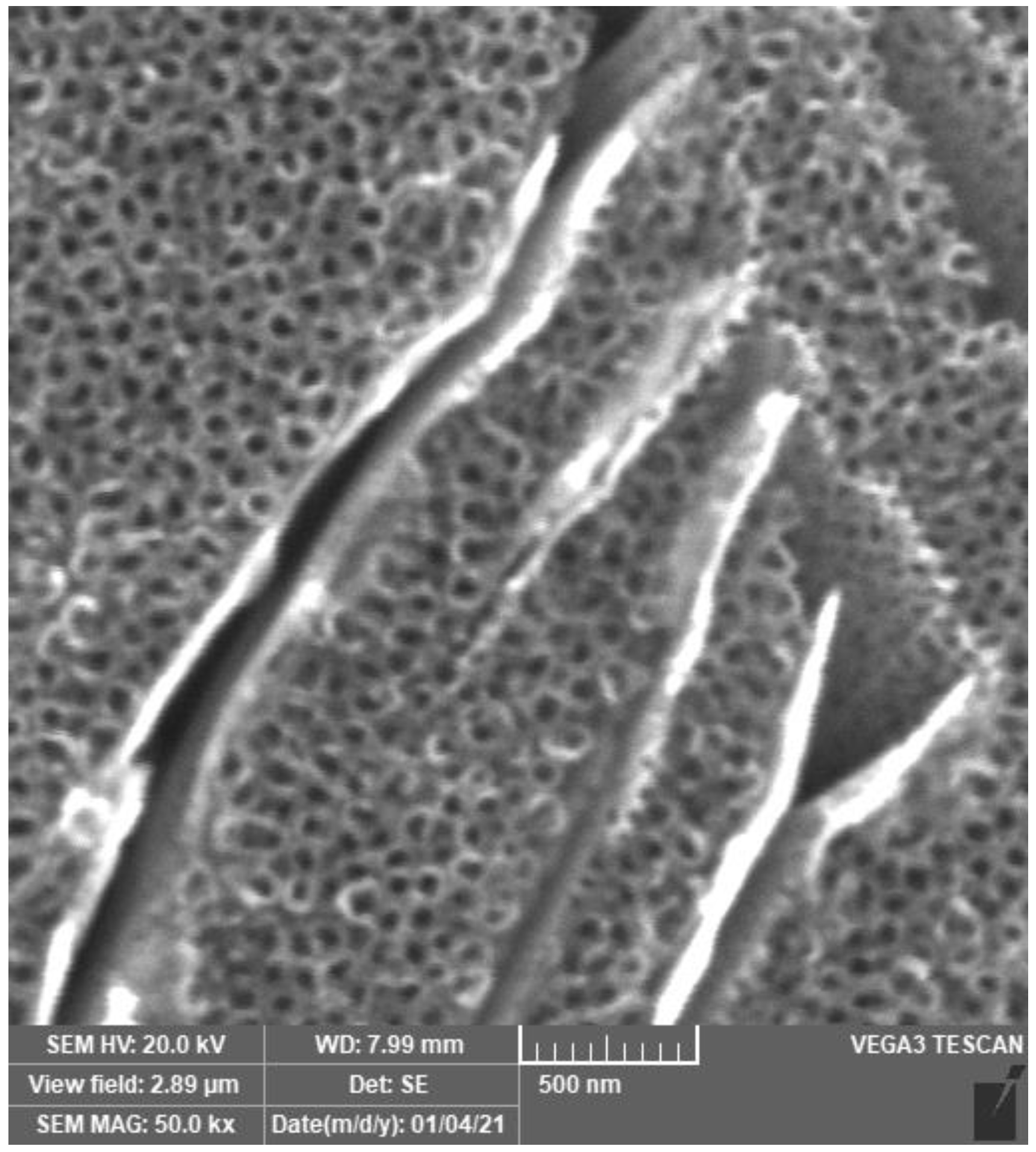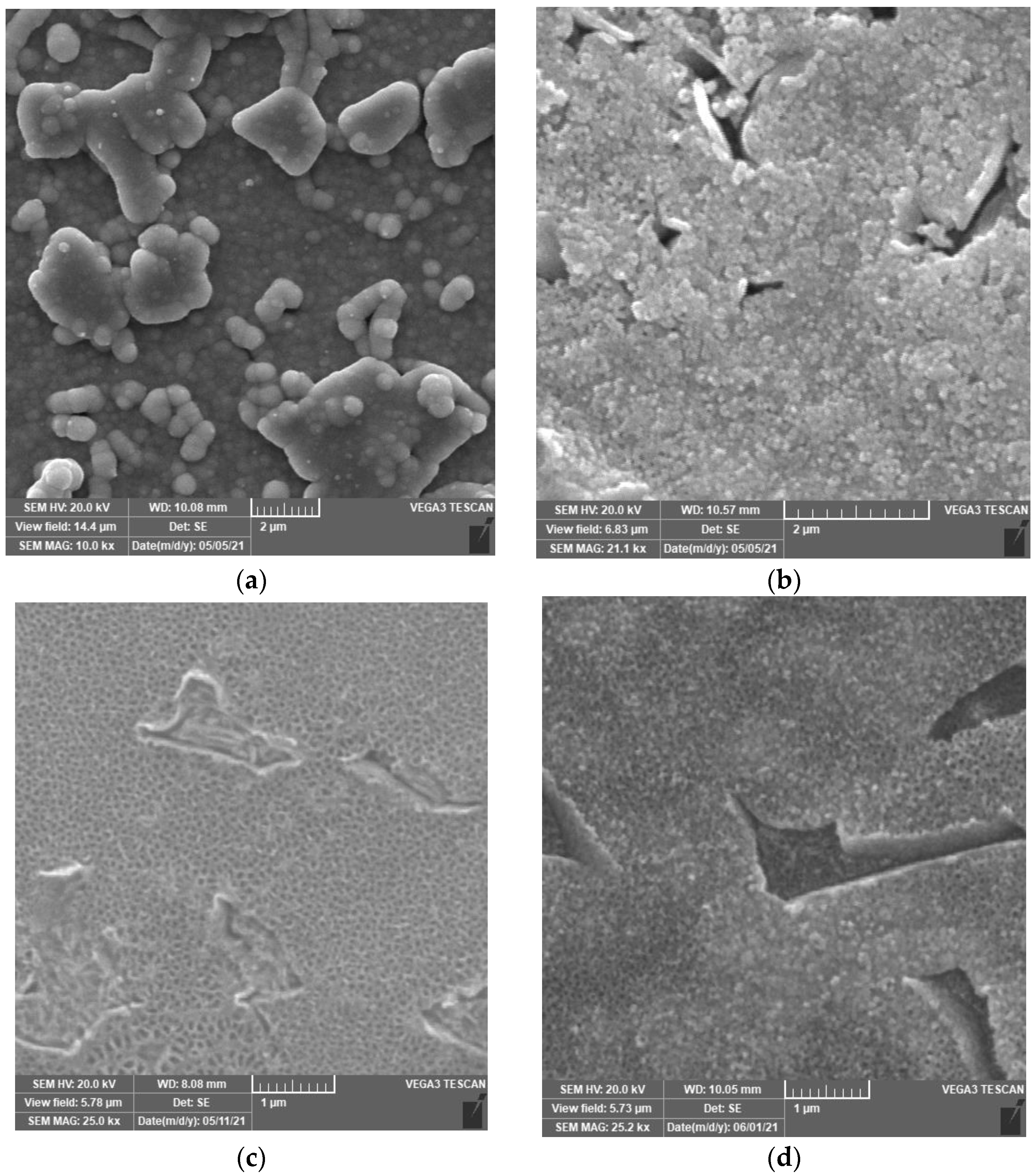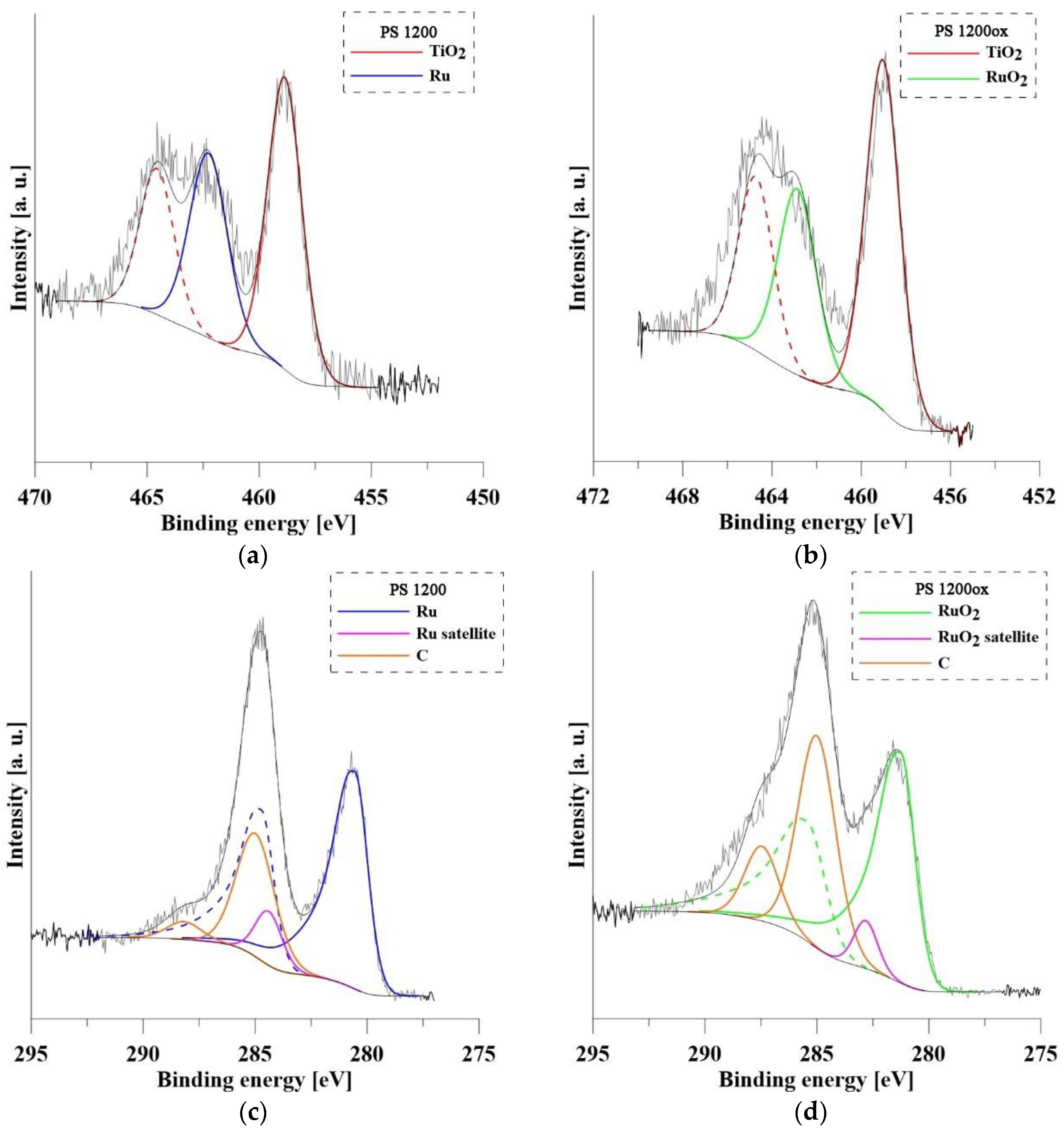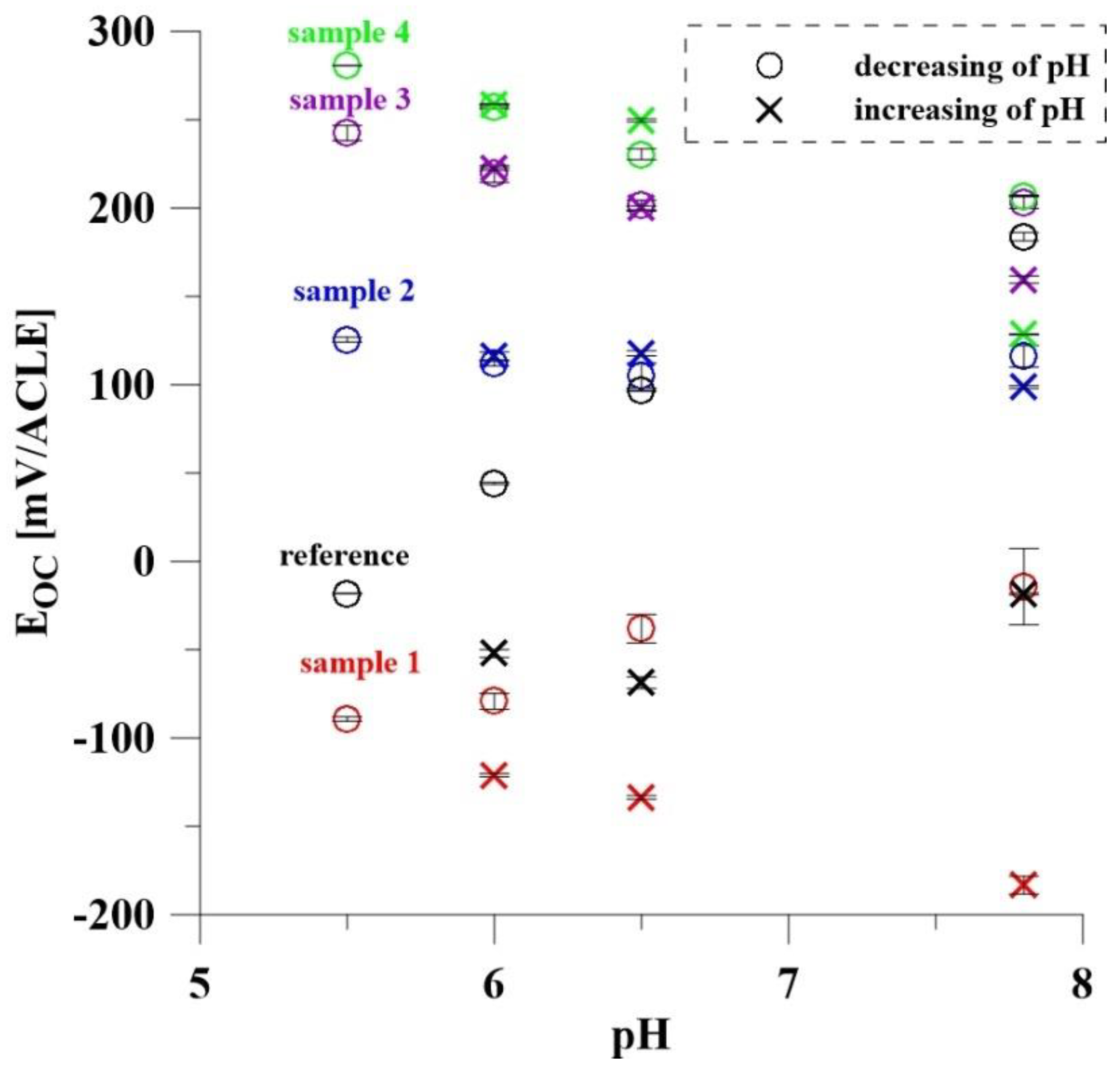A Ru/RuO2-Doped TiO2 Nanotubes as pH Sensors for Biomedical Applications: The Effect of the Amount and Oxidation of Deposited Ru on the Electrochemical Response
Abstract
:1. Introduction
2. Materials and Methods
- galvanostatic mode (GS, I = −50 mA/cm2, t = 1200 s);
- cyclic polarization (CP, potential range 1 V/ACLE to −1 V/ACLE, rate: 10 mV/s);
- potentiostatic mode (PS, E = −0.7 V/ACLE, t = 600 or 1200 s).
- PS 600 (E = −0.7 V/ACLE, t = 600 s);
- PS 600ox (E = −0.7 V/ACLE, t = 600 s + oxidation by cyclic polarization, annealing);
- PS 1200 (E = −0.7 V/ACLE, t = 1200 s);
- PS 1200ox (E = −0.7 V/ACLE, t = 1200 s + oxidation by cyclic polarization, annealing).
3. Results and Discussion
3.1. Preparation of TiO2 Nanotubes
3.2. Comparison of Deposition Methods of Ruthenium
3.3. Surface Characterization by XPS Analysis
3.4. Electrochemical Response to pH Change
- electrolyte resistance (Rs), pore electrolyte resistance (R1), charge transfer resistance (R2);
- constant phase element (CPE1) with the coefficient (α1) corresponding to the capacitance of the nanotube wall;
- constant phase element (CPE2) with the coefficient (α2) corresponding to the capacitance of the inner interface;
- infinite Warburg impedance (W) for describing diffusion in pores with the Warburg coefficient (σ).
4. Conclusions
Author Contributions
Funding
Institutional Review Board Statement
Informed Consent Statement
Data Availability Statement
Conflicts of Interest
References
- Chen, Q.; Thouas, G.A. Metallic implant biomaterials. Mater. Sci. Eng. R Rep. 2015, 87, 1–57. [Google Scholar] [CrossRef]
- Arciola, C.R.; Campoccia, D.; Montanaro, L. Implant infections: Adhesion, biofilm formation and immune evasion. Nat. Rev. Microbiol. 2018, 16, 397–409. [Google Scholar] [CrossRef]
- Souza, J.C.; Ponthiaux, P.; Henriques, M.; Oliveira, R.; Teughels, W.; Celis, J.-P.; Rocha, L.A. Corrosion behaviour of titanium in the presence of Streptococcus mutans. J. Dent. 2013, 41, 528–534. [Google Scholar] [CrossRef] [Green Version]
- Díaz, I.; Pacha-Olivenza, M.Á.; Tejero, R.; Anitua, E.; González-Martín, M.; Escudero, M.L.; Garcia-Alonso, M.C. Corrosion behavior of surface modifications on titanium dental implant. In situ bacteria monitoring by electrochemical techniques. J. Biomed. Mater. Res. Part B Appl. Biomater. 2018, 106, 997–1009. [Google Scholar] [CrossRef]
- Souza, J.C.M.; Henriques, M.; Oliveira, R.; Teughels, W.; Celis, J.P.; Rocha, L.A. Do oral biofilms influence the wear and corrosion behavior of titanium? Biofouling 2010, 26, 471–478. [Google Scholar] [CrossRef] [PubMed]
- Tang, P.; Zhang, W.; Wang, Y.; Zhang, B.; Wang, H.; Lin, C.; Zhang, L. Effect of Superhydrophobic Surface of Titanium on Staphylococcus aureus Adhesion. J. Nanomater. 2011, 2011, 178921. [Google Scholar] [CrossRef] [Green Version]
- Arciola, C.R.; Campoccia, D.; Speziale, P.; Montanaro, L.; Costerton, J.W. Biofilm formation in Staphylococcus implant infections. A review of molecular mechanisms and implications for biofilm-resistant materials. Biomaterials 2012, 33, 5967–5982. [Google Scholar] [CrossRef]
- Anderson, J.M. Future challenges in the in vitro and in vivo evaluation of biomaterial biocompatibility. Regen. Biomater. 2016, 3, 73–77. [Google Scholar] [CrossRef] [Green Version]
- Quirynen, M.; De Soete, M.; Van Steenberghe, D. Infectious risks for oral implants: A review of the literature. Clin. Oral Implant. Res. 2002, 13, 1–19. [Google Scholar] [CrossRef]
- Tallarico, M.; Canullo, L.; Caneva, M.; Özcan, M. Microbial colonization at the implant-abutment interface and its possible influence on periimplantitis: A systematic review and meta-analysis. J. Prosthodont. Res. 2017, 61, 233–241. [Google Scholar] [CrossRef] [Green Version]
- Sasarman, A.; Purvis, P.; Portelance, V. Role of Menaquinone in Nitrate Respiration in Staphylococcus aureus. J. Bacteriol. 1974, 117, 911. [Google Scholar] [CrossRef] [Green Version]
- Friedman, D.B.; Stauff, D.L.; Pishchany, G.; Whitwell, C.W.; Torres, V.; Skaar, E.P. Staphylococcus aureus Redirects Central Metabolism to Increase Iron Availability. PLoS Pathog. 2006, 2, e87. [Google Scholar] [CrossRef]
- Ghoneim, M.T.; Nguyen, A.; Dereje, N.; Huang, J.; Moore, G.C.; Murzynowski, P.J.; Dagdeviren, C. Recent Progress in Electrochemical pH-Sensing Materials and Configurations for Biomedical Applications. Chem. Rev. 2019, 119, 5248–5297. [Google Scholar] [CrossRef]
- Manjakkal, L.; Szwagierczak, D.; Dahiya, R. Metal oxides based electrochemical pH sensors: Current progress and future perspectives. Prog. Mater. Sci. 2020, 109, 100635. [Google Scholar] [CrossRef]
- Zhuiykov, S. Solid-state sensors monitoring parameters of water quality for the next generation of wireless sensor networks. Sens. Actuators B Chem. 2011, 161, 1–20. [Google Scholar] [CrossRef]
- Yusof, K.A.; Rahman, R.A.; Zulkefle, M.A.; Herman, S.H.; Abdullah, W.F.H. EGFET pH Sensor Performance Dependence on Sputtered TiO2 Sensing Membrane Deposition Temperature. J. Sens. 2016, 2016, 7594531. [Google Scholar] [CrossRef] [Green Version]
- Sardarinejad, A.; Maurya, D.; Alameh, K. The effects of sensing electrode thickness on ruthenium oxide thin-film pH sensor. Sens. Actuators A Phys. 2014, 214, 15–19. [Google Scholar] [CrossRef]
- Alfonso, E.P.; Abad, L.; Casan-Pastor, N.; Gonzalo-Ruiz, J.; Baldrich, E. Iridium oxide pH sensor for biomedical applications. Case urea–urease in real urine samples. Biosens. Bioelectron. 2013, 39, 163–169. [Google Scholar] [CrossRef]
- Mohammad-Rezaei, R.; Soroodian, S.; Esmaeili, G. Manganese oxide nanoparticles electrodeposited on graphenized pencil lead electrode as a sensitive miniaturized pH sensor. J. Mater. Sci. Mater. Electron. 2018, 30, 1998–2005. [Google Scholar] [CrossRef]
- Zhao, R.; Xu, M.; Wang, J.; Chen, G. A pH sensor based on the TiO2 nanotube array modified Ti electrode. Electrochim. Acta 2010, 55, 5647–5651. [Google Scholar] [CrossRef]
- Monteiro, G.Z.; Marques, P.A.; Pereyra, I.; Albertin, K.F. Study of pH sensors based on TiO2 nanotubes. In Proceedings of the 2014 29th Symposium on Microelectronics Technology and Devices (SBMicro), Aracaju, Brazil, 1–5 September 2014. [Google Scholar] [CrossRef]
- Manjakkal, L.; Cvejin, K.; Kulawik, J.; Zaraska, K.; Szwagierczak, D.; Socha, R.P. Fabrication of thick film sensitive RuO2-TiO2 and Ag/AgCl/KCl reference electrodes and their application for pH measurements. Sens. Actuators B Chem. 2014, 204, 57–67. [Google Scholar] [CrossRef]
- Manjakkal, L.; Zaraska, K.; Cvejin, K.; Kulawik, J.; Szwagierczak, D. Potentiometric RuO2–Ta2O5 pH sensors fabricated using thick film and LTCC technologies. Talanta 2016, 147, 233–240. [Google Scholar] [CrossRef]
- Manjakkal, L.; Djurdjic, E.; Cvejin, K.; Kulawik, J.; Zaraska, K.; Szwagierczak, D. Electrochemical Impedance Spectroscopic Analysis of RuO2 Based Thick Film pH Sensors. Electrochim. Acta 2015, 168, 246–255. [Google Scholar] [CrossRef]
- Simic, M.; Manjakkal, L.; Zaraska, K.; Stojanovic, G.M.; Dahiya, R. TiO2-Based Thick Film pH Sensor. IEEE Sens. J. 2016, 17, 248–255. [Google Scholar] [CrossRef] [Green Version]
- Hara, N.; Sugimoto, K. A Nb-Doped TiO2 Semiconductor pH Sensor for Use in High-Temperature Aqueous Solutions. J. Electrochem. Soc. 1990, 137, 2517–2523. [Google Scholar] [CrossRef]
- Naumkin, A.K.-V.; Gaarenstroom, S.W.; Powell, C.J. NIST Standard Reference Database 20, Version 4.1. 2012. Available online: https://srdata.nist.gov/xps/Default.aspx (accessed on 27 March 2021).
- X-ray Photoelectron Spectroscopy (XPS) Reference Pages. Available online: http://www.xpsfitting.com/p/about.html (accessed on 27 March 2021).
- Regonini, D.; Bowen, C.; Jaroenworaluck, A.; Stevens, R. A review of growth mechanism, structure and crystallinity of anodized TiO2 nanotubes. Mater. Sci. Eng. R Rep. 2013, 74, 377–406. [Google Scholar] [CrossRef] [Green Version]
- Matykina, E.; Conde, A.; De Damborenea, J.; y Marero, D.M.; Arenas, M.A. Growth of TiO2-based nanotubes on Ti–6Al–4V alloy. Electrochim. Acta 2011, 56, 9209–9218. [Google Scholar] [CrossRef]
- Fojt, J.; Filip, V.; Joska, L. On the increasing of adhesive strength of nanotube layers on beta titanium alloys for medical applications. Appl. Surf. Sci. 2015, 355, 52–58. [Google Scholar] [CrossRef]
- Moravec, H.; Vandrovcova, M.; Chotova, K.; Fojt, J.; Pruchova, E.; Joska, L.; Bacakova, L. Cell interaction with modified nanotubes formed on titanium alloy Ti-6Al-4V. Mater. Sci. Eng. C 2016, 65, 313–322. [Google Scholar] [CrossRef]
- Saharudin, K.A.; Sreekantan, S.; Aziz, S.N.Q.A.A.; Hazan, R.; Lai, C.W.; Mydin, R.B.S.M.N.; Mat, I. Surface Modification and Bioactivity of Anodic Ti6Al4V Alloy. J. Nanosci. Nanotechnol. 2013, 13, 1696–1705. [Google Scholar] [CrossRef]
- Filova, E.; Fojt, J.; Kryslova, M.; Moravec, H.; Joska, L.; Bacakova, L. The diameter of nanotubes formed on Ti-6Al-4V alloy controls the adhesion and differentiation of Saos-2 cells. Int. J. Nanomed. 2015, 10, 7145–7163. [Google Scholar] [CrossRef] [Green Version]
- Oppedisano, D.K.; Jones, L.A.; Junk, T.; Bhargava, S.K. Ruthenium Electrodeposition from Aqueous Solution at High Cathodic Overpotential. J. Electrochem. Soc. 2014, 161, D489–D494. [Google Scholar] [CrossRef]
- Xie, Y.; Fu, D. Supercapacitance of ruthenium oxide deposited on titania and titanium substrates. Mater. Chem. Phys. 2010, 122, 23–29. [Google Scholar] [CrossRef]
- Jow, J.-J.; Lee, H.-J.; Chen, H.-R.; Wu, M.-S.; Wei, T.-Y. Anodic, cathodic and cyclic voltammetric deposition of ruthenium oxides from aqueous RuCl3 solutions. Electrochim. Acta 2007, 52, 2625–2633. [Google Scholar] [CrossRef]
- Chen, C.-C.; Hsieh, S.-J. Evaluation of fluorine ion concentration in TiO2 NT anodization process. J. Electrochem. Soc. 2010, 157, K125. [Google Scholar] [CrossRef]
- Chastain, J.; King, R.C., Jr. Handbook of X-ray Photoelectron Spectroscopy; Perkin-Elmer Corporation: Eden Prairie, MN, USA, 1992; p. 221. [Google Scholar]
- Chen, J.; Qiu, S.; Yang, L.; Xu, Z.; Deng, Y.; Xu, Y. Effects of oxygen, hydrogen and neutron irradiation on the mechanical properties of several vanadium alloys. J. Nucl. Mater. 2002, 302, 135–142. [Google Scholar] [CrossRef]
- Sugawara, Y.; Yadav, A.P.; Nishikata, A.; Tsuru, T. EQCM Study on Dissolution of Ruthenium in Sulfuric Acid. J. Electrochem. Soc. 2008, 155, B897–B902. [Google Scholar] [CrossRef]
- Rajamäki, K.; Nordström, T.; Nurmi, K.; Åkerman, K.E.; Kovanen, P.T.; Öörni, K.; Eklund, K.K. Extracellular Acidosis Is a Novel Danger Signal Alerting Innate Immunity via the NLRP3 Inflammasome. J. Biol. Chem. 2013, 288, 13410–13419. [Google Scholar] [CrossRef] [Green Version]
- Macdonald, J.R.; Barsoukov, E. Impedance Spectroscopy: Theory, Experiment, and Applications; John Wiley & Sons: Hoboken, NJ, USA, 2018; ISBN 9781119074083. [Google Scholar] [CrossRef]
- Orazem, M.E.; Tribollet, B. Electrochemical Impedance Spectroscopy; John Wiley & Sons: Hoboken, NJ, USA, 2008; ISBN 9780470041406. [Google Scholar] [CrossRef]








| Measurement | Conditions |
|---|---|
| EOC | 720 min |
| 5 cycles | |
| EOC | 10 s |
| EIS | 0 V/EOC, EAC = 10 mV RMS, f = 60 kHz–2 mHz, 7 points to decade |
| EOC | 200 s |
| MS | −0.8 V/ACLE to 0.5 V/ACLE, step 0.1 V, f = 600 Hz, EAC = 10 mV RMS |
| Content [wt.%] | Ti | Al | V | Ru | F |
|---|---|---|---|---|---|
| GS | 5.0 | 0.2 | 0.3 | 94.3 | 0.2 |
| CP | 49.4 | 2.3 | 2.3 | 45.2 | 0.8 |
| PS 600 | 84.0 | 5.4 | 4.1 | 2.5 | 4.0 |
| PS 600ox | 83.4 | 5.4 | 3.8 | 2.7 | 4.7 |
| PS 1200 | 81.0 | 4.8 | 4.0 | 7.2 | 3.0 |
| PS 1200ox | 78.3 | 5.0 | 3.8 | 12.9 | 0.0 |
| Sample/Weight of Ru | PS 600 | PS 600ox | PS 1200 | PS 1200ox |
|---|---|---|---|---|
| m [mg] | 0.17 | 0.37 | 1.38 | 3.25 |
| Content [wt.%] | PS 1200 | PS 1200ox |
|---|---|---|
| Ti | 24.8 | 28.8 |
| Al | 8.0 | 10.3 |
| Ru | 67.2 | 60.9 |
| pH | Rs [Ω·cm2] | R1 [Ω·cm2] | CPE1 [S·sα/cm2] | α1 | W [S·s0.5/cm2] | R2 [Ω·cm2] | CPE2 [S·sα/cm2] | α2 | σ [Ω·s1·cm2] | χ2 | |
|---|---|---|---|---|---|---|---|---|---|---|---|
| reference sample | 7.8 | 29.06 | 4.5 × 103 | 1.1 × 10−5 | 0.91 | 4.8 × 10−5 | 1.5 × 105 | 9.5 × 10−5 | 0.80 | 1.5 × 104 | 8.5 × 10−5 |
| 6.5 | 32.42 | 1.6 × 103 | 1.1 × 10−5 | 0.91 | 3.4 × 10−5 | 5.5 × 105 | 4.6 × 10−5 | 0.80 | 2.1 × 104 | 2.4 × 10−4 | |
| 6.0 | 28.64 | 5.9 × 103 | 1.7 × 10−5 | 0.90 | 4.1 × 10−5 | 9.2 × 104 | 2.5 × 10−5 | 0.75 | 1.7 × 103 | 4.7 × 10−4 | |
| 5.5 | 31.39 | 2.8 × 103 | 1.1 × 10−5 | 0.92 | 5.2 × 10−5 | 1.9 × 105 | 7.4 × 10−5 | 0.75 | 1.4 × 104 | 1.8 × 10−4 | |
| 6.0 | 31.41 | 3.2 × 103 | 1.2 × 10−5 | 0.91 | 6.4 × 10−5 | 1.1 × 105 | 9.9 × 10−5 | 0.75 | 1.1 × 104 | 1.2 × 10−4 | |
| 6.5 | 30.45 | 3.5 × 103 | 1.2 × 10−5 | 0.91 | 6.6 × 10−5 | 9.9 × 104 | 1.0 × 10−4 | 0.75 | 1.1 × 104 | 1.4 × 10−4 | |
| 7.8 | 29.06 | 4.5 × 103 | 1.1 × 10−5 | 0.91 | 4.8 × 10−5 | 1.5 × 105 | 9.5 × 10−5 | 0.80 | 1.5 × 104 | 8.5 × 10−5 | |
| PS 600 | 7.8 | 30.99 | 0.0 | 4.9 × 10−6 | 1.00 | 2.8 × 10−4 | 2.6 × 105 | 2.3 × 10−5 | 0.75 | 2.5 × 103 | 1.9 × 10−4 |
| 6.5 | 29.14 | 4.0 × 103 | 1.6 × 10−5 | 0.90 | 3.5 × 10−4 | 1.1 × 105 | 2.1 × 10−5 | 0.75 | 2.0 × 103 | 3.3 × 10−4 | |
| 6.0 | 28.64 | 5.9 × 103 | 1.7 × 10−5 | 0.90 | 4.1 × 10−4 | 9.2 × 104 | 2.5 × 10−5 | 0.75 | 1.7 × 103 | 4.7 × 10−4 | |
| 5.5 | 28.26 | 7.9 × 103 | 1.8 × 10−5 | 0.90 | 4.0 × 10−4 | 8.5 × 104 | 2.9 × 10−5 | 0.75 | 1.8 × 103 | 7.4 × 10−4 | |
| 6.0 | 27.90 | 7.5 × 103 | 1.7 × 10−5 | 0.90 | 4.0 × 10−4 | 8.2 × 104 | 3.5 × 10−5 | 0.75 | 1.8 × 103 | 6.3 × 10−4 | |
| 6.5 | 27.36 | 7.0 × 103 | 1.6 × 10−5 | 0.91 | 4.2 × 10−4 | 7.8 × 104 | 3.8 × 10−5 | 0.75 | 1.7 × 103 | 4.6 × 10−4 | |
| 7.8 | 27.03 | 1.0 × 104 | 1.6 × 10−5 | 0.91 | 4.0 × 10−4 | 8.2 × 104 | 3.3 × 10−5 | 0.75 | 1.8 × 103 | 5.5 × 10−4 | |
| PS 600ox | 7.8 | 31.93 | 6.6 × 104 | 1.8 × 10−5 | 0.91 | 4.3 × 10−5 | 2.1 × 105 | 7.8 × 10−6 | 0.80 | 1.7 × 104 | 1.2 × 10−4 |
| 6.5 | 30.60 | 4.6 × 104 | 2.0 × 10−5 | 0.90 | 4.8 × 10−5 | 1.7 × 105 | 8.1 × 10−6 | 0.80 | 1.5 × 104 | 1.1 × 10−4 | |
| 6.0 | 29.38 | 3.9 × 104 | 2.1 × 10−5 | 0.89 | 4.7 × 10−5 | 1.6 × 105 | 7.6 × 10−6 | 0.80 | 1.5 × 104 | 9.4 × 10−5 | |
| 5.5 | 29.80 | 3.0 × 104 | 2.2 × 10−5 | 0.89 | 4.6 × 10−5 | 1.7 × 105 | 7.0 × 10−6 | 0.80 | 1.5 × 104 | 9.4 × 10−5 | |
| 6.0 | 28.70 | 2.5 × 104 | 2.1 × 10−5 | 0.89 | 4.3 × 10−5 | 1.5 × 105 | 8.7 × 10−6 | 0.80 | 1.6 × 104 | 9.7 × 10−5 | |
| 6.5 | 28.01 | 2.2 × 104 | 2.0 × 10−5 | 0.90 | 4.1 × 10−5 | 1.3 × 105 | 1.0 × 10−5 | 0.80 | 1.7 × 104 | 1.0 × 10−4 | |
| 7.8 | 27.33 | 2.8 × 104 | 1.7 × 10−5 | 0.91 | 3.9 × 10−5 | 1.2 × 105 | 1.0 × 10−5 | 0.80 | 1.8 × 104 | 1.0 × 10−4 | |
| PS 1200 | 7.8 | 33.41 | 3.5 × 103 | 1.7 × 10−5 | 0.86 | 6.2 × 10−5 | 5.0 × 105 | 7.9 × 10−5 | 0.81 | 1.1 × 104 | 2.6 × 10−4 |
| 6.5 | 30.76 | 2.3 × 103 | 1.6 × 10−5 | 0.88 | 7.4 × 10−5 | 1.9 × 105 | 1.7 × 10−4 | 0.90 | 9.6 × 103 | 2.2 × 10−4 | |
| 6.0 | 29.77 | 2.0 × 103 | 1.5 × 10−5 | 0.88 | 7.6 × 10−5 | 1.3 × 105 | 2.0 × 10−4 | 0.91 | 9.3 × 103 | 2.2 × 10−4 | |
| 5.5 | 29.68 | 1.9 × 103 | 1.5 × 10−5 | 0.88 | 8.1 × 10−5 | 1.3 × 105 | 1.9 × 10−4 | 0.91 | 8.8 × 103 | 2.3 × 10−4 | |
| 6.0 | 28.79 | 2.2 × 103 | 1.5 × 10−5 | 0.89 | 7.5 × 10−5 | 1.3 × 105 | 1.9 × 10−4 | 0.89 | 9.5 × 103 | 1.8 × 10−4 | |
| 6.5 | 27.67 | 2.7 × 103 | 1.4 × 10−5 | 0.89 | 7.2 × 10−5 | 1.3 × 105 | 1.8 × 10−4 | 0.87 | 9.9 × 103 | 1.6 × 10−4 | |
| 7.8 | 27.32 | 5.2 × 103 | 1.4 × 10−5 | 0.89 | 5.7 × 10−5 | 1.3 × 105 | 1.2 × 10−4 | 0.80 | 1.2 × 104 | 2.3 × 10−4 | |
| PS 1200ox | 7.8 | 33.00 | 57.7 | 1.3 × 10−5 | 0.88 | 6.7 × 10−3 | 8.6 × 105 | 9.6 × 10−4 | 0.84 | 1.1 × 102 | 8.6 × 10−5 |
| 6.5 | 28.30 | 90.6 | 1.5 × 10−5 | 0.87 | 9.3 × 10−3 | 1.1 × 105 | 2.6 × 10−3 | 0.93 | 7.6 × 101 | 8.6 × 10−5 | |
| 6.0 | 31.00 | 65.7 | 1.4 × 10−5 | 0.88 | 9.8 × 10−3 | 1.7 × 105 | 3.0 × 10−3 | 0.92 | 7.2 × 101 | 9.6 × 10−5 | |
| 5.5 | 29.30 | 75.9 | 1.4 × 10−5 | 0.87 | 1.1 × 10−3 | 1.6 × 105 | 2.1 × 10−3 | 0.88 | 6.4 × 102 | 1.8 × 10−4 | |
| 6.0 | 29.00 | 85.6 | 1.4 × 10−5 | 0.87 | 8.4 × 10−3 | 1.3 × 105 | 2.5 × 10−3 | 0.92 | 8.4 × 101 | 1.4 × 10−4 | |
| 6.5 | 28.30 | 90.6 | 1.5 × 10−5 | 0.97 | 9.3 × 10−3 | 1.1 × 105 | 2.6 × 10−3 | 0.93 | 7.6 × 101 | 8.6 × 10−5 | |
| 7.8 | 26.90 | 96.9 | 1.3 × 10−5 | 0.88 | 8.0 × 10−3 | 1.7 × 105 | 2.5 × 10−3 | 0.93 | 8.8 × 101 | 9.7 × 10−5 |
Publisher’s Note: MDPI stays neutral with regard to jurisdictional claims in published maps and institutional affiliations. |
© 2021 by the authors. Licensee MDPI, Basel, Switzerland. This article is an open access article distributed under the terms and conditions of the Creative Commons Attribution (CC BY) license (https://creativecommons.org/licenses/by/4.0/).
Share and Cite
Macháčková, N.; Jírů, J.; Hybášek, V.; Fojt, J. A Ru/RuO2-Doped TiO2 Nanotubes as pH Sensors for Biomedical Applications: The Effect of the Amount and Oxidation of Deposited Ru on the Electrochemical Response. Materials 2021, 14, 7912. https://doi.org/10.3390/ma14247912
Macháčková N, Jírů J, Hybášek V, Fojt J. A Ru/RuO2-Doped TiO2 Nanotubes as pH Sensors for Biomedical Applications: The Effect of the Amount and Oxidation of Deposited Ru on the Electrochemical Response. Materials. 2021; 14(24):7912. https://doi.org/10.3390/ma14247912
Chicago/Turabian StyleMacháčková, Nikola, Jitřenka Jírů, Vojtěch Hybášek, and Jaroslav Fojt. 2021. "A Ru/RuO2-Doped TiO2 Nanotubes as pH Sensors for Biomedical Applications: The Effect of the Amount and Oxidation of Deposited Ru on the Electrochemical Response" Materials 14, no. 24: 7912. https://doi.org/10.3390/ma14247912
APA StyleMacháčková, N., Jírů, J., Hybášek, V., & Fojt, J. (2021). A Ru/RuO2-Doped TiO2 Nanotubes as pH Sensors for Biomedical Applications: The Effect of the Amount and Oxidation of Deposited Ru on the Electrochemical Response. Materials, 14(24), 7912. https://doi.org/10.3390/ma14247912






